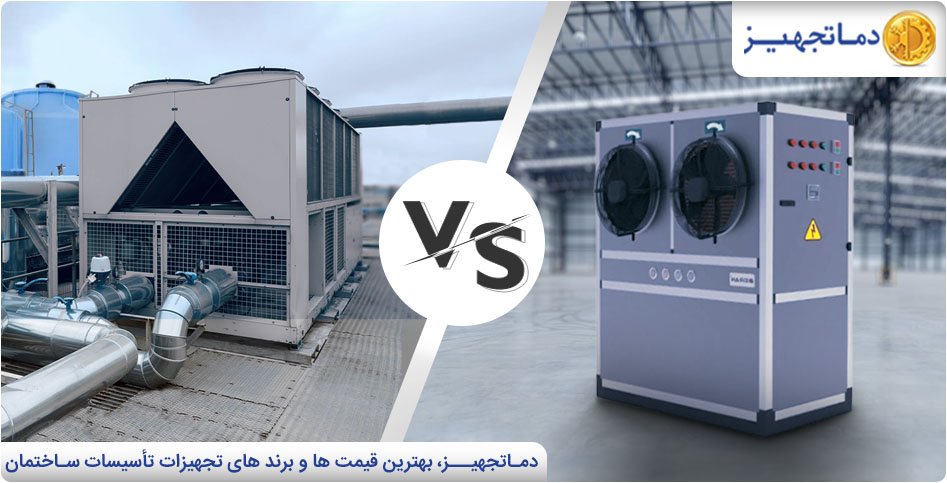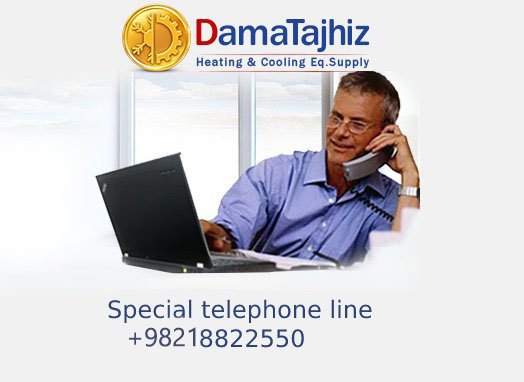- سحر وظیفه
- Cooling and Ventilation Equipment
- 0 likes
- 1931 views
- 1 comments
These days, in order to bring the ambient air to the desired and optimal temperature in the hot seasons of the year, it is necessary to use cooling equipment, one of these important and advanced equipment is chillers. In general, chillers are the heart of any central cooling system that cools the ambient air temperature by lowering the water temperature and making it flow through the coils of cooling equipment such as fan coils and air conditioners. In terms of performance, chillers have compression and absorption types that are produced and supplied on industrial and domestic scales.
Mini chillers are actually small air-cooled chillers that are used in small residential buildings, workshops and small-sized environments. Mini chillers have a capacity of less than 20 tons of refrigeration and are very quiet. These devices are usually installed on the terrace or roof of the building and are used in units that want to have independent cooling. The most widely used type of mini chillers are scroll air-cooled mini chillers, which are completely similar to compression chillers and operate on the basis of the compression refrigeration cycle, and in a closed circuit, they cool the water of the refrigeration system of each unit.
Chiller and mini chiller both have similar functions and components (compressor, evaporator, condenser, expansion valve, and refrigerant), but they have differences.

The difference between chiller and mini chiller in terms of refrigeration capacity or tonnage
The most important difference between an air cooled chiller and a mini chiller is their cooling capacity. Most mini chillers have a capacity of up to 10 tons of refrigeration, while the capacity of chillers is 10 tons of refrigeration and above. Mini chillers are usually used in small to medium size buildings and central chillers are used in large sizes and buildings.
The difference between compression chillers and mini chillers in the compressor type
Since scroll type compressors are used in smaller capacities, scroll type (sometimes rotary) compressors are usually used in mini chillers due to their smaller tonnage, which have very high efficiency and longer life. . But in compression chillers, due to the high tonnage of the device, usually piston, screw, scroll compressors and in some cases centrifugal compressors are used, which are selected according to the needs of each project.
The difference between chiller and mini chiller is in the type of condenser
As you know, condensers are divided into two types of air cooled (air) and water cooled (water). Refrigerant in water condensers is cooled by cooling tower water, and in air condensers by ventilation fan. Therefore, in air-cooled compression chillers (air chillers) whose condenser is air-type, there is no need for a cooling tower and there is no water consumption in them, but water-cooled compression chillers (water chillers) have a water condenser and are connected to the cooling tower. needs.
Since mini chillers are a type of air-cooled compression chillers, they have air condensers that do not use water. For this reason, mini chillers should be placed outside the building.
The difference in the components of chiller and mini chiller
The constituent parts of air compression chillers and mini chillers are very similar to each other, except that the cold water pump and expansion source of the compression chiller are installed independently. While in the mini chiller, the water pump and the expansion source are integrated and installed inside the mini chiller itself.
Also, chillers have more accessories that affect their size and price. For example, a cooling tower is needed in a central water compression chiller, while mini chillers do not use a cooling tower, which increases the price of chillers compared to mini chillers.
The difference between chiller and mini chiller in electricity consumption
When comparing the amount of electricity consumption of chillers and mini chillers, the cooling capacity and electricity consumption of the total of mini chillers used in the building should be considered. In this case, the electricity consumption of a set of mini chillers of all units (with equivalent capacity) is more than the electricity consumption of a central chiller in the building.
The difference in how to connect the chiller and mini chiller to the air conditioner and fan coil
The difference between chiller and mini chiller is the way they are connected to the cooling coil of the air conditioner and the fan coil. As you know, cold or hot air is distributed in two ways in the building. In the first method, an air conditioner is installed centrally and its air is transferred to different units in a building through a channel. In the second method, a fan coil is installed in every room of the hall or part of the building. Water cooled by a chiller or mini chiller (or hot water by a package or boiler) is sent to the air conditioner coil or fan coil with a pump and it circulates in the coil until the fan blows air from the coil to create cool air inside the building. to provide
There is another type of system called DX coil. In the system equipped with DX coil, there is no water in the cooling circuit and the refrigerant itself is directly connected (through piping) to the air conditioner or fan coil (such as the evaporator of splits). If the chiller and air conditioner are connected in this way, it is called a package unit.
Possibility of continuous use of chiller and mini chiller
If several mini-chillers are used in a building, if one device fails, other devices will be used, and in fact, the failure of one device will not mean that the entire refrigeration system will be suspended. But if the circuit of a central chiller fails, the cooling of the entire building will face problems.
It is worth noting that due to the use of several compressors in chillers, the possibility of their failure is very low.
Important note: For an approximate estimate of the refrigeration capacity required in each unit or building (in relatively mild weather conditions such as Tehran, Karaj, Mashhad, Isfahan, Sulaymaniyah, Erbil, Kirkuk, Aleppo, Latakia, Kabul, Beirut, Mazar-e-Sharif, etc. ), you can consider about 4 tons of refrigeration capacity per 100 square meters of infrastructure. This approximate estimate is regardless of the type of equipment selected such as central chiller (water or air), mini chiller or even the use of split ducts and splits.
DamaTajhiz; The best prices and brands of construction equipment
final word
In this article, we tried to compare chiller and mini chiller. You can visit the site of Dematajhiz specialized collection (the first and most reliable specialized collection in the field of building installation equipment and all ventilation devices) to view and compare all types of chillers and mini chillers with different brands and capacities, as well as to know their updated prices. Please refer to Mhabib since 2013 and having 3 valid business licenses.
You can contact the heating equipment sales experts during office hours to get more information and advice.
Related Articles
In order to get more information, it is recommended to read the articles related to the mini chiller capacity calculation article.
THE DIFFERENCE BETWEEN A CHILLER AND A COOLING TOWER
CHILLER OF COOLING TOWER
MINI CHILLER DIMENSIONS
MINI CHILLER POWER CONSUMPTION
THE DIFFERENCE BETWEEN ABSORPTION AND COMPRESSION CHILLERS

We are waiting for your call and look forward to meeting you in the specialized Damatajhiz collection
By sharing the above article on social networks, let your friends know about its important content.
Related products
Havasaz Mini Chiller HLMC-9-1
- Compressor type: scroll (Danfoss or Copeland)
- Refrigerant gas: R22
- Equipped with evaporator from the plate heat exchanger
- It has an expansion valve, thermostat, solenoid valve, and safety
- Made of the galvanized sheet of suitable thickness
Warranty:
1-year warranty
After-sales services:
10 years
- Out-of-Stock







Comments (1)